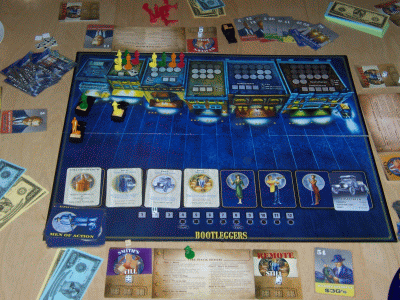Manufacturer: Eagle Games
Author: D. Beyer, R. Eifler and S. Gross
Number of Players: 3-6
Age: 12 years plus
Time: about 90 mins.
Year: 2004
ENGLISH MAIN PAGE
 Deutsche Spielerezension
Deutsche Spielerezension
| Bootleggers |
| General Information: Manufacturer: Eagle Games Author: D. Beyer, R. Eifler and S. Gross Number of Players: 3-6 Age: 12 years plus Time: about 90 mins. Year: 2004 ENGLISH MAIN PAGE  Deutsche Spielerezension Deutsche Spielerezension |
 |
| Game Components: 120 Influence Markers - 20 Trucks - 6 Family Stills - 6 Remote Stills - 1 Gameboard - 1 Copper Figur - 80 Men of Action Cards - 14 Truck Cards - 72 Muscle Cards - 70 wooden cubes - 25 Dices - Money - 1 Rulebook |
| Further
Information: - Homepage of Eagle Games |
| Troudi says 9 of
10 points: At first actually I felt a bit sceptic about the game: As in most American games the components are plentiful and look just beautiful. But I was a bit afraid of the typical American dice game relying just on luck and only being a strategic game by name. "Eagle Games" now distance themselves from that "tradition": Mr. Gross, one of the authors, told us that he and his colleagues desired to create an American-European mix of traditional game elements. They wanted to combine the mechanisms of a typical European strategy game and the interactional elements of American games. And they succeeded: The concept works very well and a great game is the outcome: The game is fluent, exciting and especially the trading phase provides a kind of interaction not to be found very often in European games. Strategical elements have been incorporated as well: Players have to plan carefully which muscle card they want to use and how much they want to invest in order to be the first player (or not the last one). Eagle Games is going to publish a whole series of such games and I hope that such games as this one will be fortcoming. The game is only available in English and cost around 40 dollars. But in my opinion the 40 dollars have never before been such a good investion in an American game. If you do not want to spend the money try Bootleggers out and decide afterwards. |